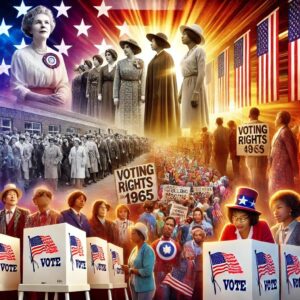From exclusion to empowerment, the story of voting rights in the United States is one of resilience, courage, and a continuous push toward fairness. At the heart of this journey is a fundamental principle: everyone deserves a voice in the decisions that shape their lives. But the road to universal suffrage has been long and winding, marked by key milestones and fierce battles for equality. Let’s take a look at how voting rights have evolved over the years, focusing on landmark moments like the 19th Amendment, the Voting Rights Act, and recent efforts to ensure all voices are heard.
When the United States was founded, voting was far from universal. In the late 18th century, the right to vote was largely restricted to white, land-owning men. This limited concept of who “deserved” to vote left out entire populations—women, people of color, and individuals who didn’t meet property qualifications. As the nation grew, so did the belief that more citizens should have a say in governance. However, it would take well over a century for substantial changes to emerge.
The fight for women’s suffrage was a turning point in American history, marked by the passionate activism of women like Susan B. Anthony, Elizabeth Cady Stanton, and countless others. For decades, women organized, marched, and protested for the right to vote. Their efforts culminated in the ratification of the 19th Amendment in 1920, a landmark achievement that granted women the right to vote. This amendment was monumental, not just because it expanded the electorate but because it empowered half of the population to have a say in laws that affected them.
While the 19th Amendment was a significant step, racial discrimination continued to disenfranchise Black voters and other minority groups, especially in the South. Practices like literacy tests, poll taxes, and outright intimidation were used to prevent people of color from voting. The Civil Rights Movement, led by figures like Dr. Martin Luther King Jr., highlighted these injustices, bringing national attention to the need for change. The result was the Voting Rights Act of 1965, a sweeping piece of legislation that aimed to eliminate racial discrimination in voting. By banning literacy tests and authorizing federal oversight in areas with a history of discrimination, the act opened the door for millions of Americans to exercise their rights freely.
Today, voting rights remain a dynamic issue, as activists work to expand access in the face of new challenges. Recent years have seen an increase in state-level voter ID laws and restrictions on mail-in voting, which some argue create barriers to voting. However, technology and advocacy groups have stepped up to bridge these gaps. Initiatives like early voting, same-day registration, and online voter registration aim to make voting easier and more inclusive, especially for young people, low-income individuals, and communities of color.
The fight for voting rights is ongoing. Every generation faces new challenges to ensuring that democracy truly reflects the will of the people. Through continued efforts to secure fair and equal access, America can move closer to fulfilling its promise of a government by and for all.
This journey reminds us that voting is not just a right; it’s a symbol of equality, power, and freedom.

